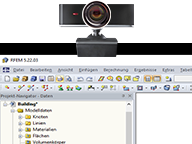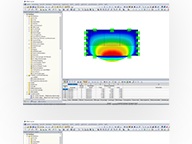Extension of RF-DYNAM Pro – Natural Vibrations for Time History Analysis and Multi-Modal Response Spectrum Analysis
RF-/DYNAM Pro - Forced Vibrations | Features of Time History Analysis
- Combination of user-defined time diagrams with load cases or load combinations (nodal, member, and surface loads, as well as free and generated loads, can be combined with time-variable functions)
- Combination of several independent excitation functions
- Extensive library of seismic events (accelerograms)
- Linear implicit Newmark analysis or modal analysis in time history
- Structural damping using Rayleigh damping coefficients or Lehr's damping
- Direct import of initial deformations from a load case or combination
- Graphical display of results in a time history diagram
- Export of results in user-defined time steps or as an envelope
RF-/DYNAM Pro - Forced Vibrations | Features of Multi-Modal Response Spectrum Analysis
- Response spectra of numerous standards (ASCE 7-16, NBC 2015, etc.)
- User-defined response spectra or those generated from accelerograms
- Direction-relative response spectrum approach
- Manual or automatic selection of the relevant mode shapes of response spectra (5% rule of EC 8 applicable)
- Result combinations by modal superimposition (SRSS or CQC rule) and by direction superimposition (SRSS or 100% / 30% rule)
RF-/DYNAM Pro - Forced Vibrations | Input
It is necessary to enter the required response spectra, accelerations, or time diagrams. Dynamic load cases define the location and direction of response spectra effects as well as acceleration time, or force-time excitations.
Timing diagrams are combined with static load cases, which provides great flexibility. For the time history analysis, you can import the initial deformation from any load case or load combination.
RF-/DYNAM Pro - Forced Vibrations | Calculation
The time history analysis is performed with the modal analysis or the linear implicit Newmark analysis. The time history analysis in this add‑on module is restricted to linear systems. Although the modal analysis represents a fast algorithm, it is necessary to use a certain number of eigenvalues to ensure the required accuracy of results.
The implicit Newmark analysis is a very precise method, independent of the number of eigenvalues used, but requires sufficient small time steps for calculation. For the response spectra analysis, equivalent static loads are calculated internally. A linear static analysis is performed subsequently.
RF-/DYNAM Pro - Forced Vibrations | Results
Due to the integration of RF‑/DYNAM Pro in RFEM / RSTAB, you can incorporate numeric and graphic results from RF‑/DYNAM Pro – Forced Vibrations in the global printout report. Also, all RFEM options are available for a graphical visualization.
The results of the time history analysis are displayed in a time course monitor. All results are displayed as a function of time. You can export the numeric values to MS Excel.
In the case of a time history analysis, you can export results of the individual time steps or filter most unfavourable results of all time steps.
The response spectrum analysis generates result combinations. Internally, the modal contributions and the directional components of earthquake actions are combined.
Calculate Your Price

The price is valid for United States.








.png?mw=192&hash=f63e4a3f1836233005de32f60201d5392e507cf1)



